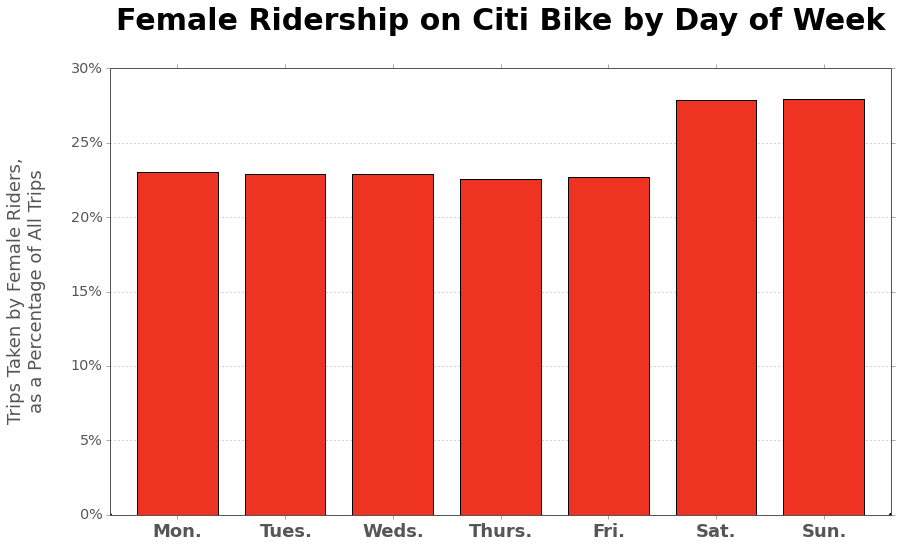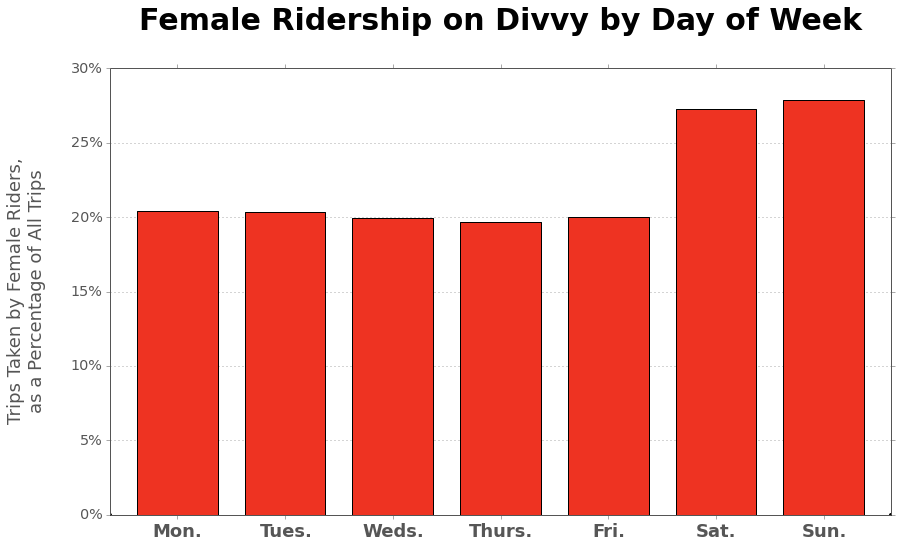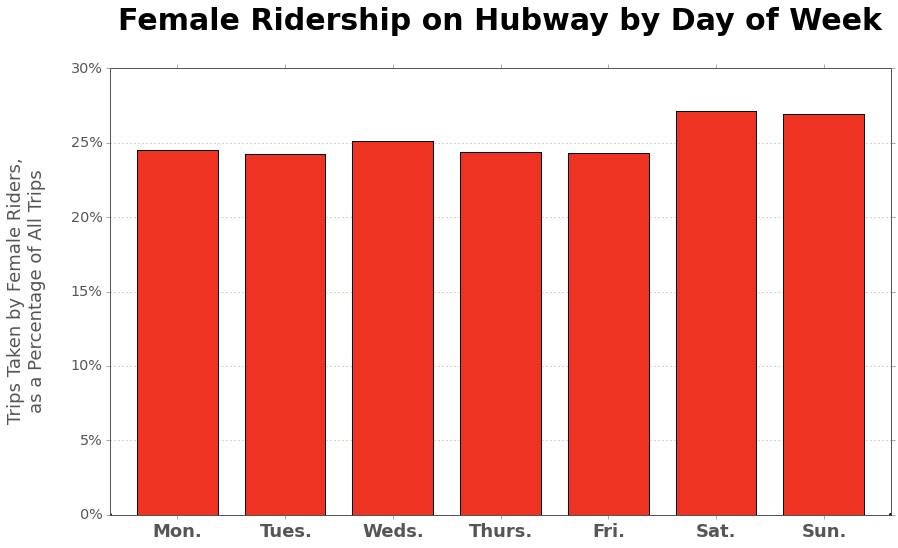Women ride bicycles one-third as often as men do.
What's up with that? Bike-sharing programs have some answers, such as where and when women are most and least likely to hop on a bike.
Three of the largest programs in the U.S. have published trip data that includes gender: New York's Citi Bike, Chicago's Divvy, and Boston's Hubway. While bikeshare habits don't necessarily reflect overall bike-riding trends, the data provides possibly the most detailed view of gender and biking ever publicly available for these cities.
In this map and the others below, you can explore the gender balance at each bikeshare station during the five months — July 1 through November 30, 2013 — that appear in all three cities' published data.
Overall, women took 24% of all Citi Bike member trips during these five months, the same nationwide rate found in the government's 2009 National Household Travel Survey. But there's a clear trend:
Midtown and Wall Street are much more male-dominated than other parts of town.
The five most-male stations are all between 33rd Street and 43rd Street. Though no station comes close to a 50/50 gender balance, the most-female stations are clustered around the Lower East Side, the East Village, and near Fort Greene Park in Brooklyn.
The large gender gaps in Manhattan's business neighborhoods may reflect the additional burdens that women face in commuting. In 2012, Jennifer Langston summarized a handful of prevalent explanations for this phenomenon:
Why don't women bike to work more often? You hear many theories: we're less willing to ride in traffic, we can't arrive at a showerless office all sweaty, we never bothered to learn how to fix a flat, our schedules are over-extended, we work longer hours to make the same money as men, those of us with kids spend twice as much time on average caring for them, and many of us squeeze in shopping and errands on the way to and from work.
Beyond these possible explanations, bikeshare programs may provide another wrinkle. "Women trip-chain more than men do," says Carolyn Szczepanski, director of communications for the League of American Bicyclists and founder of League's Women Bike program. "As they're going to work, they're dropping off a child. As they're returning from work, they're picking up groceries." While the convenience of bikeshare programs may appeal to women, Szczepanski theorizes that the bikes' time restrictions and cargo-carrying limitations may dissuade them.
Whatever the root cause, Citi Bike's gender gap shrinks on weekends; the female ridership rate is five percentage points higher on Saturdays and Sundays than during the workweek.

In these charts and maps, "Female ridership" is defined as the percentage of members' trips starting or ending at a given station that were taken by women. You can find more information about the data and our methodology at the bottom of this post.
Citi Bike, which just celebrated its one-year anniversary, is the largest bikeshare program in the country, with 330 stations and 6,000 bikes. (At least officially; the actual number of bikes may be somewhat lower.)
Chicago — Divvy
Divvy is the second-largest bike sharing program in the country, with 300 stations and approximately 3,000 bikes. (Washington, D.C.'s Capital Bikeshare has more stations but fewer bikes and lower daily ridership.)
During our five-month sample, women accounted for 21.4% of Divvy members' trips, the lowest among the three programs we examined, but not by much.
As in New York, Chicago's busiest, most business-centric neighborhoods were home to the largest gender gaps among members' trips.
And, also as in New York, Divvy's gender gap shrinks noticeably on the weekend.

Divvy has declared this June to be Chicago's first-ever Women's Bike Month , "to raise the profile of women who bike and encourage more women to consider biking both for recreational and practical purposes." When Divvy publishes its next batch of data, we might be able to see if their advocacy worked.
Boston — Hubway
With 140 stations and 1,300 bikes after a recent expansion, Boston's Hubway is the country's fifth-largest program, behind Washington D.C. and the Twin Cities.
During the five-month sample, women accounted for 25% of Hubway members' trips.
Stations near Boston and Cambridge's main business centers appear to have lower ridership than more peripheral stations, much as in Chicago and New York. But the weekday/weekend difference is less pronounced — about 2.5 percentage points, or half the difference in New York and a third of that in Chicago. (Perhaps because of all the college students?)

The analyses, maps, and charts above represent just a small fraction of what's possible with bikeshare data. If you mashed up Citi Bike data with New York's bike lane data, what would you find? How does weather affect ridership rates and the gender gap in each of these cities? Are younger riders more likely to bike uphill than older riders? To help answer these questions, BuzzFeed has open-sourced the data and tools we used to create these maps. For more information, read the section below.
Data and Methodology
• The maps and charts in this post are derived from publicly available data that the bikeshare programs themselves have published. You can find direct links to the data, and tips for handling it, here. (One limitation: The data includes gender for bikeshare members but not for riders who only buy single-use passes.)
• Because time-of-year likely affects the biking gender gap, we chose to limit our analyses and maps to the five months — July 1 to November 30, 2013 — common to the three programs' available data. Even so, it's possible that differences in weather, and other outside factors affect city-to-city comparisons.
• We've open-sourced the computer scripts that create the maps and charts above. In addition to the CSV files that power the map, we've generated GeoJSON files of the same data.
• Finally: To make it easier to handle and analyze bikeshare data in a standard way, we've built and open-sourced a Python library that normalizes the various differences between each dataset. Currently, it supports trip and station data from Citi Bike, Divvy, and Hubway.
